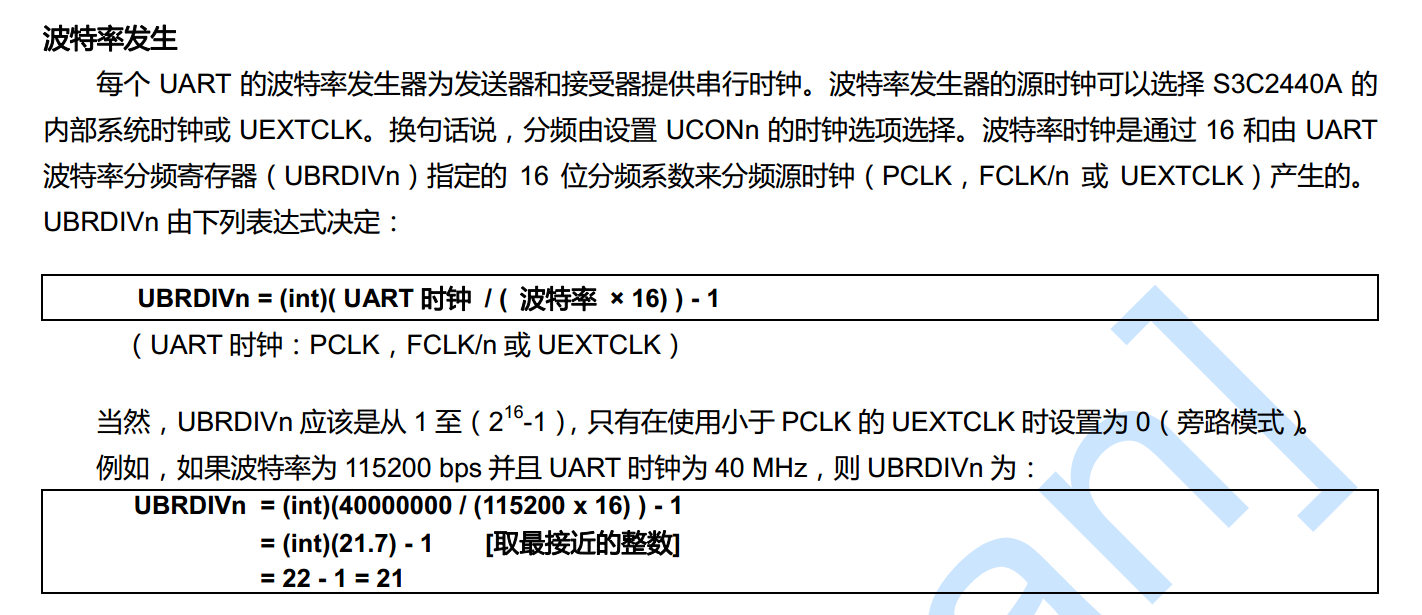S3C2440串口的基本使用
阿新 • • 發佈:2017-11-05
mod start pin tex 說明 bit signed logs --
2440A有三個串口,我們使用串口0對它進行了解熟悉。
首先肯定是應該找到手冊上串口0所對應的引腳,然後配置相應寄存器。
串口0對應GPIO H的 2,3

串口在單片機中我們已經有很多使用經驗了,對於協議采用 8-N-1,8bit數據位,無校驗,1停止位。
說明波特率的計算方式:


把串口對應IO配置成 TX和RX功能之後,我們需要對指定寄存器進行讀寫操作,實現串口的接發。
具體的寄存器就不貼出來了。手冊上都有,這裏不使用FIFO和中斷方式,只是最基本的接發操作。
main.c:
#include "s3c2440_gpio.h" #include "s3c2440_soc.h" #include"uart.h" void SystemInit(void) { //配置LOCKTIME(0x4C000000) = 0xFFFFFFFF *(volatile unsigned int *)0x4C000000=0xFFFFFFFF; //CLKDIVN(0x4C000014) = 0X5, tFCLK:tHCLK:tPCLK = 1:4:8 *(volatile unsigned int *)0x4C000014=0x5; //協處理指令 __asm__( "mrc p15, 0, r1, c1, c0, 0\n" /* 讀出控制寄存器 */ "orr r1, r1, #0xc0000000\n" /* 設置為“asynchronous bus mode” */ "mcr p15, 0, r1, c1, c0, 0\n" /* 寫入控制寄存器 */ ); /* 設置MPLLCON(0x4C000004) = (92<<12)|(1<<4)|(1<<0) * m = MDIV+8 = 92+8=100 * p = PDIV+2 = 1+2 = 3 * s = SDIV = 1 * FCLK = 2*m*Fin/(p*2^s) = 2*100*12/(3*2^1)=400M */*(volatile unsigned int *)0x4C000004=(92<<12)|(1<<4)|(1<<0); } void Delay(uint32_t count) { while(count--); } int main(void) { //配置GPIOF 0,2,GPIOG 3為輸入模式 Set_gpio(IN, GPIOF,GPIO_PinSource0); Set_gpio(IN, GPIOF,GPIO_PinSource2); Set_gpio(IN, GPIOG,GPIO_PinSource3); //點亮LED1然後熄滅 Reset_gpio(OUT, GPIOF,GPIO_PinSource4); Delay(100000); Set_gpio(OUT, GPIOF,GPIO_PinSource4); Delay(100000); //點亮LED2然後熄滅 Reset_gpio(OUT, GPIOF,GPIO_PinSource5); Delay(100000); Set_gpio(OUT, GPIOF,GPIO_PinSource5); Delay(100000); //點亮LED3然後熄滅 Reset_gpio(OUT, GPIOF,GPIO_PinSource6); Delay(100000); Set_gpio(OUT, GPIOF,GPIO_PinSource6); Delay(100000); //熄滅三盞LED燈 Set_gpio(OUT, GPIOF,GPIO_PinSource5); Set_gpio(OUT, GPIOF,GPIO_PinSource4); unsigned char c; uart_init(); puts("Hello, world!\n\r"); while (1) { while(1) { c = getchar(); if (c == ‘\r‘) { putchar(‘\n‘); } if (c == ‘\n‘) { putchar(‘\r‘); } putchar(c); } } return 0; }
uart.c:
#include "uart.h" #include "s3c2440_soc.h" #define PCLK 50000000 // PCLK為50MHz #define UART_CLK PCLK // UART0的時鐘源設為PCLK #define UART_BAUD_RATE 115200 // 波特率 #define UART_BRD ((int)(UART_CLK / (UART_BAUD_RATE * 16.0)+0.5) - 1) #define NULL 0 void uart_init(void) { /* GPH2,3用於TxD0, RxD0 */ //清除GPHCON GPHCON &= ~((3<<4) | (3<<6)); //設置2,3為發送接收 GPHCON |= ((2<<4) | (2<<6)); //使能內部上拉 GPHUP &= ~((1<<2) | (1<<3)); ULCON0 = 0x03; // 8N1(8個數據位,無校驗,1個停止位) UCON0 = 0x05; // 中斷/查詢模式,UART時鐘源為PCLK UFCON0 = 0x00; // 不使用FIFO UMCON0 = 0x00; // 不使用流控 UBRDIV0 = UART_BRD; // 波特率為115200 } int putchar(int c) { /* UTRSTAT0 */ /* UTXH0 */ /*發送是向寄存器寫數據*/ while (!(UTRSTAT0 & (1<<2))); UTXH0 = (unsigned char)c; return 0; } int getchar(void) { //接收是在寄存器中讀數據 while (!(UTRSTAT0 & (1<<0))); return URXH0; } int puts(const char *s) { if(s!=NULL) { while (*s) { putchar(*s); s++; } } return 0; }
配置串口,要註意波特率,還有是否有緩存,實際應用中,FIFO是不可缺少的,這裏只是入門簡單實現。
啟動文件和之前的時鐘章節一樣,
Makefile:
all: arm-linux-gcc -c -g -o s3c2440_gpio.o s3c2440_gpio.c arm-linux-gcc -c -g -o uart.o uart.c arm-linux-gcc -c -g -o main.o main.c arm-linux-gcc -c -g -o start.o start.S arm-linux-ld -Ttext 0 start.o main.o s3c2440_gpio.o uart.o -o uart.elf arm-linux-objcopy -O binary -S uart.elf uart.bin arm-linux-objdump -S -D uart.elf > uart.dis clean: rm *.bin *.o *.elf *.dis
NOTE:
在此之後,還是不去編寫庫函數了,太過於消耗時間,使用寄存器配置的方式,如果工作中需要長期使用某個cpu或mcu時,再去編寫對應的庫函數,因為時間實在不夠。
S3C2440串口的基本使用
